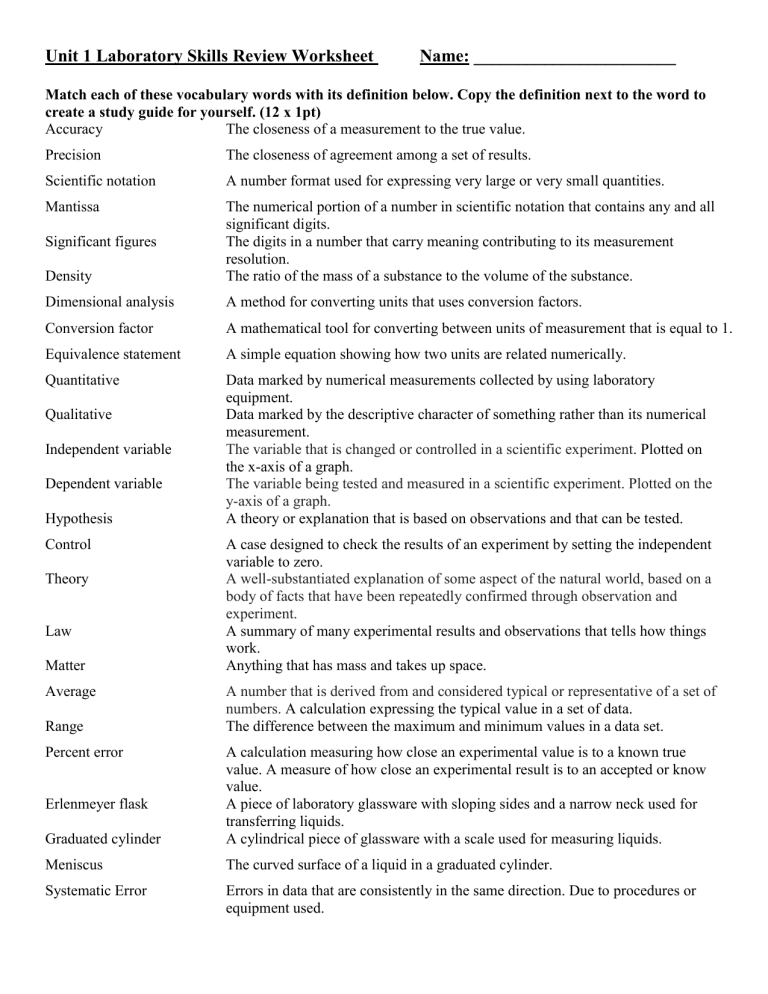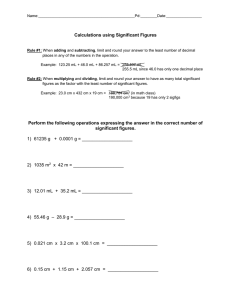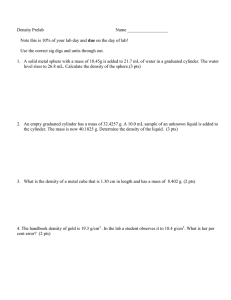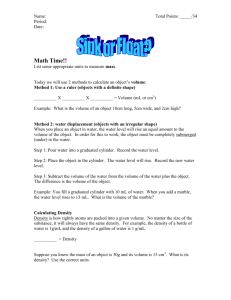Lab Skills Review Worksheet: Accuracy, Conversions, Density
advertisement

Unit 1 Laboratory Skills Review Worksheet Name: _______________________ Match each of these vocabulary words with its definition below. Copy the definition next to the word to create a study guide for yourself. (12 x 1pt) Accuracy The closeness of a measurement to the true value. Precision The closeness of agreement among a set of results. Scientific notation A number format used for expressing very large or very small quantities. Mantissa Density The numerical portion of a number in scientific notation that contains any and all significant digits. The digits in a number that carry meaning contributing to its measurement resolution. The ratio of the mass of a substance to the volume of the substance. Dimensional analysis A method for converting units that uses conversion factors. Conversion factor A mathematical tool for converting between units of measurement that is equal to 1. Equivalence statement A simple equation showing how two units are related numerically. Quantitative Data marked by numerical measurements collected by using laboratory equipment. Data marked by the descriptive character of something rather than its numerical measurement. The variable that is changed or controlled in a scientific experiment. Plotted on the x-axis of a graph. The variable being tested and measured in a scientific experiment. Plotted on the y-axis of a graph. A theory or explanation that is based on observations and that can be tested. Significant figures Qualitative Independent variable Dependent variable Hypothesis Control Theory Law Matter Average Range Percent error A case designed to check the results of an experiment by setting the independent variable to zero. A well-substantiated explanation of some aspect of the natural world, based on a body of facts that have been repeatedly confirmed through observation and experiment. A summary of many experimental results and observations that tells how things work. Anything that has mass and takes up space. A number that is derived from and considered typical or representative of a set of numbers. A calculation expressing the typical value in a set of data. The difference between the maximum and minimum values in a data set. Graduated cylinder A calculation measuring how close an experimental value is to a known true value. A measure of how close an experimental result is to an accepted or know value. A piece of laboratory glassware with sloping sides and a narrow neck used for transferring liquids. A cylindrical piece of glassware with a scale used for measuring liquids. Meniscus The curved surface of a liquid in a graduated cylinder. Systematic Error Errors in data that are consistently in the same direction. Due to procedures or equipment used. Erlenmeyer flask Random Error Mole Errors (in either direction) in measured data due to the limitations of the measurement device. A unit representing 6.022 x 1023 items often used to count atoms. 2. Identify the following Laboratory Equipment (3 x 1pt) Any item on the image of lab equipment or located in the classroom is fair game. Bunsen Burner Erlenmeyer flask Beaker Graduated cylinder Crucible w/ lid Forceps/Tongs 3. Measurement (2 x 3pts) Measure the following items to the proper number of significant figures using the scales provided. Remember to estimate in between the smallest gradations on any scale. On the test you may have a real graduated cylinder to read, or a mass to weigh using a triple beam balance, or a physical object to measure, or an image to measure or read like below. a) mL b) Measure length in cm using a standard ruler. 5.86 -5.89 mL (NOT greater than 5.90 or just 5.9 mL) Must have 2 decimal places 4.66 cm – 4.68 cm (NOT 4.65, 4.69 or 4.6 or 4.7) Must have 2 decimal places c) 3.26 cm or 3.28 cm or 3.27 cm (NOT 3.29 cm or 3.25 cm or 3.3 cm) Must have 2 decimal places d) mL 15.0 mL or 14.9 mL or 15.1 mL (NOT 14.8 mL or 15.5 mL or 15 mL) Must have 1 decimal place 4. Convert between Scientific Notation and Standard Notation (4 x 2 pts) a. 0.00000978 L _9.78 x 10-6 L__ d. 6.130 x 10-9 m 0.000000006130 m b. 837,100,000 cm3 _8.371 x 108 cm3_ e. 1.2552 x 107 J 12,552,000 J c. 0.005930 g _5.950 x 10-3 g_ f. 1.05 x 109 Hz 1,050,000,000 Hz 5. Identify number of Significant figures present in each number (4 x 2pts) a. 0.000450 cm __3___ d. 350 m __2___ b. 3.5 x 103 kg __2___ e. 0.0030 sec __2___ c. 60,700 hours __3___ f. 1.00 x 103 mL __3___ 6. Round to the given number of sigfig. Express in scientific notation if you need to use more than 3 zeros. (3 x 2 pts) a. 9,837,420,058 to 4 sigfigs _9,837,000,000___ c. 509,800,528,620 to 3 sigfigs __5.10 x 1011____ b. 0.0003890026 to 4 sigfigs _0.0003890______ d. 52.8905 to 3 decimal places 7. Add or Subtract, give answer in correct # of sigfigs. (4 x 2 pts) a. 3750 g + 42 g ____3790 g_______________ b. 33.604 cm – 17.2 cm ____16.4 cm_______________ c. 2.71 x 10-4 s – 4.36 x 10-5 s ___0.000227 s________________ d. 2.81 x 104 m + 4.8 x 102 m ___28,600 m________________ 8. Multiply or Divide, give answer in correct # of sigfigs. (4 x 2 pts) a. (12.05 m)(0.041 m)(2.53 m) b. c. 28.75 𝑔 14.0 𝑚𝐿 8.20 × 10−3 𝑔 1.531 ×10−2 𝑠 1.2 m3 2.05 g/mL 0.536 g/s d. (2.4 x 103 cm)(1.58 x 101 cm)(4 x 103 cm) 2 x 108 cm3 ___52.891_____ 9. Perform the following metric conversions using any method you prefer. Show your work. (3 x 3pts) a. 350 g to mg 350,000 mg b. 0.000430 s to μs 430 μs c. 405,000,000 mL to kL d. 0.00207 m2 to cm2 405 kL 20.7 cm2 e. 3.6 x 10-8 mg to ng 3.6 x 10-2 ng or 0.036 ng 10. Perform the following conversions using dimensional analysis. (Factor label method.) Show your work. (2 x 4 pts) a. 13.5 mL to L 𝟏𝑳 𝟏𝟑. 𝟓 𝒎𝑳 ∙ = 𝟎. 𝟎𝟏𝟑𝟓 𝑳 𝟏𝟎𝟎𝟎 𝒎𝑳 b. 153 km to cm 𝟏𝟓𝟑 𝒌𝒎 ∙ 𝟏𝟎𝟎𝟎 𝒎 𝟏𝟎𝟎 𝒄𝒎 𝟏 𝒌𝒎 ∙ 𝟏𝒎 ∙= 1.53 x 107 cm c. 3.50 years to sec 𝟑. 𝟓𝟎 𝒚𝒓𝒔 ∙ 365.25 𝑑 𝟐𝟒 𝒉𝒓𝒔 𝟔𝟎 𝒎𝒊𝒏 𝟔𝟎 𝒔𝒆𝒄 𝟏 𝒚𝒓 ∙ 𝟏 𝒅𝒂𝒚 ∙ 𝟏 𝒉𝒓 ∙ 𝟏 𝒎𝒊𝒏 = 1.10 x 108 sec 11. Solve these density problems: (3 x 3 pts) a. A 5.75 g object is submerged in 22.5 mL of water is raising the water level to 24.1 mL What is the density of this object? Volume = 24.1 mL – 22.5 mL = 1.6 mL d = m/V d = 5.75 g / 1.6 mL = 3.6 g/mL b. What volume does an iron iron have if its mass is 2.35 kg? (The density of iron is 7.86 g/cm3.) Use either d = m/V or V = m/d. Notice 2.35 kg = 2350 g. V = 2350 g / 7.86 g/cm3 V= 299 cm3 c. What is the mass of a 350 cm3 ingot of copper? (The density of copper is 8.96 g/cm3.) Use either d =m/V or m = Vd m = 350 cm3 (8.96 g/cm3) = 3100 g






